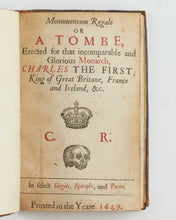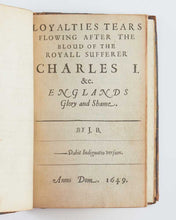[CLEVELAND, John (attributed author).] Monumentum Regale or a tombe, erected for that incomparable and glorious monarch, Charles the First, King of Great Britane, France and Ireland, &c. In select elegies, epitaphs, and poems. [London: William Bentley.] 1649.
[bound with:]
B[IRKENHEAD], J[ohn]. Loyalties tears flowing after the bloud of the royall sufferer Charles I. &c. Englands glory and shame. [London?: n.p.]. “1649”. [i.e. 1650].
Two works in one vol. 8vo. Contemporary calf, rebacked, blind double rule border to boards, spine blind-ruled in compartments, lettered directly in gilt to one, edges sprinkled red, endpapers renewed; Monumentum: pp. [2], 46, title and pp. 2 and 3 printed in black and red, woodcut skull and crown to title, typographic headpieces; Loyalties: [2 (blank)], [2], 11, [1 (blank)], bound without 8-page advertisement; boards and extremities a little worn; light, uniform toning throughout, occasional very light dampstaining to lower margin, trimmed close at head and foot in places, occasionally touching page numbering and shaving last line of p. 41 of 1st work; ink scribbling to final blank verso of 2nd work; bookplate of the Fox Pointe Collection to front free endpaper.
First edition of Cleveland’s collection of royalist verse and second edition of Birkenhead’s poem: two rare clandestine publications commemorating Charles I, composed in the immediate aftermath of his execution.
Published anonymously, Monumentum Regale is a collection of eight poetical works of varying length traditionally attributed to the poet and satirist John Cleveland (c. 1613-1658). Modern scholarship, however, has reassigned all but one of the texts – the sixth elegy – to other authors, including Josh Ashburnham, Payne Fisher, Thomas Pierce, and Henry King. A fervent royalist, Cleveland accompanied Charles during the Civil War until the king’s surrender to the Scots at Newark, and wrote one of the most biting caricatures of Oliver Cromwell (The Character of a London-Diurnall, 1645). Little is known of his life after the war, though “there has been a reasonable assumption that, in Berdan’s words, ‘[l]ike the great majority of the unfortunate cavaliers, he wandered about in complete dependence upon his more fortunate friends’” (ODNB). The collection comprises: 1. “Epitaph” beginning “Behold the Mirror”, 2. “Chronostichon decollationis Caroli Regis”, 3. “An Elegie on the Meekest of Men, the most glorious of Princes, the most Constant of Martyrs, Charles the I”, 4. “Caroli Τοῦ Μακαρίτου Παλιγγενεσία”, 5. “A Deep Groan, fetch’d at the Funerall of that incomparable and Glorious Monarch, Charles the First”, 6. “An Elegie” beginning “Were not my Faith”, 7. “An Elegie” beginning “Does not the Sun”, 8. “An Epitaph” beginning “Whitin the Sacred Vault”. The Monumentum, sometimes found bound in copies of the Eikon Basilike, was issued twice in 1649; this is the version with “yeare” in the imprint and without the ninth poem “Upon the Death of King Charles”.
The second work, Loyalties Tears Flowing, is a 240-line monody – an extended poem of grieving – on Charles’s execution by the poet, journalist and satirist Sir John Birkenhead (c. 1617-1679). Best remembered for his newsbooks, including Mercurius Britannicus, Birkenhead’s poetic talent “has perhaps been unfairly minimised” (ODNB). Author of the longest known commendatory poem in existence (240 lines dedicated to William Cartwright), several of his lyrics were set to music by Henry Lawes (1596-1662). First published in 1649, Loyalties Tears Flowing “exhibits less of the satirical stridency that characterises much of Birkenhead’s writing and more a sense of controlled indignation and genuine sorrow” (ibid.). At the Restoration, his loyalty was rewarded: he regained his Oxford fellowship, received a doctorate of civil law at the king’s recommendation, and from 1660 to 1663 held the office of Licenser of the Press.
Monumentum: ESTC R208852 (version with “yeare” imprint); Madan 107. Loyalties: ESTC R209196 (only six locations recorded).
#2122558






